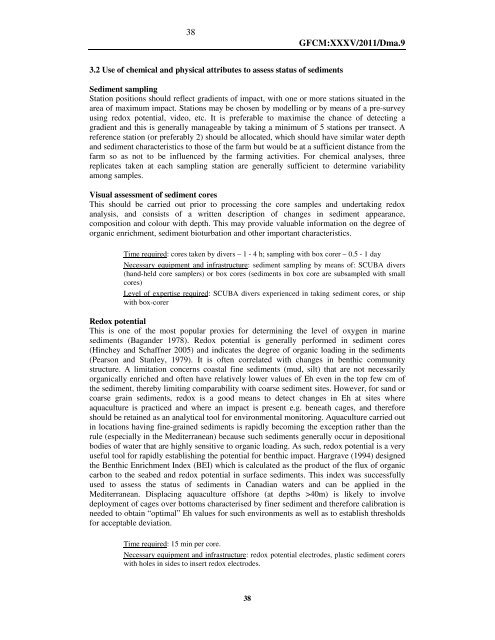Site selection and carrying capacity in Mediterranean ... - FAO Sipam
Site selection and carrying capacity in Mediterranean ... - FAO Sipam
Site selection and carrying capacity in Mediterranean ... - FAO Sipam
You also want an ePaper? Increase the reach of your titles
YUMPU automatically turns print PDFs into web optimized ePapers that Google loves.
38<br />
3.2 Use of chemical <strong>and</strong> physical attributes to assess status of sediments<br />
38<br />
GFCM:XXXV/2011/Dma.9<br />
Sediment sampl<strong>in</strong>g<br />
Station positions should reflect gradients of impact, with one or more stations situated <strong>in</strong> the<br />
area of maximum impact. Stations may be chosen by modell<strong>in</strong>g or by means of a pre-survey<br />
us<strong>in</strong>g redox potential, video, etc. It is preferable to maximise the chance of detect<strong>in</strong>g a<br />
gradient <strong>and</strong> this is generally manageable by tak<strong>in</strong>g a m<strong>in</strong>imum of 5 stations per transect. A<br />
reference station (or preferably 2) should be allocated, which should have similar water depth<br />
<strong>and</strong> sediment characteristics to those of the farm but would be at a sufficient distance from the<br />
farm so as not to be <strong>in</strong>fluenced by the farm<strong>in</strong>g activities. For chemical analyses, three<br />
replicates taken at each sampl<strong>in</strong>g station are generally sufficient to determ<strong>in</strong>e variability<br />
among samples.<br />
Visual assessment of sediment cores<br />
This should be carried out prior to process<strong>in</strong>g the core samples <strong>and</strong> undertak<strong>in</strong>g redox<br />
analysis, <strong>and</strong> consists of a written description of changes <strong>in</strong> sediment appearance,<br />
composition <strong>and</strong> colour with depth. This may provide valuable <strong>in</strong>formation on the degree of<br />
organic enrichment, sediment bioturbation <strong>and</strong> other important characteristics.<br />
Time required: cores taken by divers – 1 - 4 h; sampl<strong>in</strong>g with box corer – 0.5 - 1 day<br />
Necessary equipment <strong>and</strong> <strong>in</strong>frastructure: sediment sampl<strong>in</strong>g by means of: SCUBA divers<br />
(h<strong>and</strong>-held core samplers) or box cores (sediments <strong>in</strong> box core are subsampled with small<br />
cores)<br />
Level of expertise required: SCUBA divers experienced <strong>in</strong> tak<strong>in</strong>g sediment cores, or ship<br />
with box-corer<br />
Redox potential<br />
This is one of the most popular proxies for determ<strong>in</strong><strong>in</strong>g the level of oxygen <strong>in</strong> mar<strong>in</strong>e<br />
sediments (Bag<strong>and</strong>er 1978). Redox potential is generally performed <strong>in</strong> sediment cores<br />
(H<strong>in</strong>chey <strong>and</strong> Schaffner 2005) <strong>and</strong> <strong>in</strong>dicates the degree of organic load<strong>in</strong>g <strong>in</strong> the sediments<br />
(Pearson <strong>and</strong> Stanley, 1979). It is often correlated with changes <strong>in</strong> benthic community<br />
structure. A limitation concerns coastal f<strong>in</strong>e sediments (mud, silt) that are not necessarily<br />
organically enriched <strong>and</strong> often have relatively lower values of Eh even <strong>in</strong> the top few cm of<br />
the sediment, thereby limit<strong>in</strong>g comparability with coarse sediment sites. However, for s<strong>and</strong> or<br />
coarse gra<strong>in</strong> sediments, redox is a good means to detect changes <strong>in</strong> Eh at sites where<br />
aquaculture is practiced <strong>and</strong> where an impact is present e.g. beneath cages, <strong>and</strong> therefore<br />
should be reta<strong>in</strong>ed as an analytical tool for environmental monitor<strong>in</strong>g. Aquaculture carried out<br />
<strong>in</strong> locations hav<strong>in</strong>g f<strong>in</strong>e-gra<strong>in</strong>ed sediments is rapidly becom<strong>in</strong>g the exception rather than the<br />
rule (especially <strong>in</strong> the <strong>Mediterranean</strong>) because such sediments generally occur <strong>in</strong> depositional<br />
bodies of water that are highly sensitive to organic load<strong>in</strong>g. As such, redox potential is a very<br />
useful tool for rapidly establish<strong>in</strong>g the potential for benthic impact. Hargrave (1994) designed<br />
the Benthic Enrichment Index (BEI) which is calculated as the product of the flux of organic<br />
carbon to the seabed <strong>and</strong> redox potential <strong>in</strong> surface sediments. This <strong>in</strong>dex was successfully<br />
used to assess the status of sediments <strong>in</strong> Canadian waters <strong>and</strong> can be applied <strong>in</strong> the<br />
<strong>Mediterranean</strong>. Displac<strong>in</strong>g aquaculture offshore (at depths >40m) is likely to <strong>in</strong>volve<br />
deployment of cages over bottoms characterised by f<strong>in</strong>er sediment <strong>and</strong> therefore calibration is<br />
needed to obta<strong>in</strong> “optimal” Eh values for such environments as well as to establish thresholds<br />
for acceptable deviation.<br />
Time required: 15 m<strong>in</strong> per core.<br />
Necessary equipment <strong>and</strong> <strong>in</strong>frastructure: redox potential electrodes, plastic sediment corers<br />
with holes <strong>in</strong> sides to <strong>in</strong>sert redox electrodes.
















